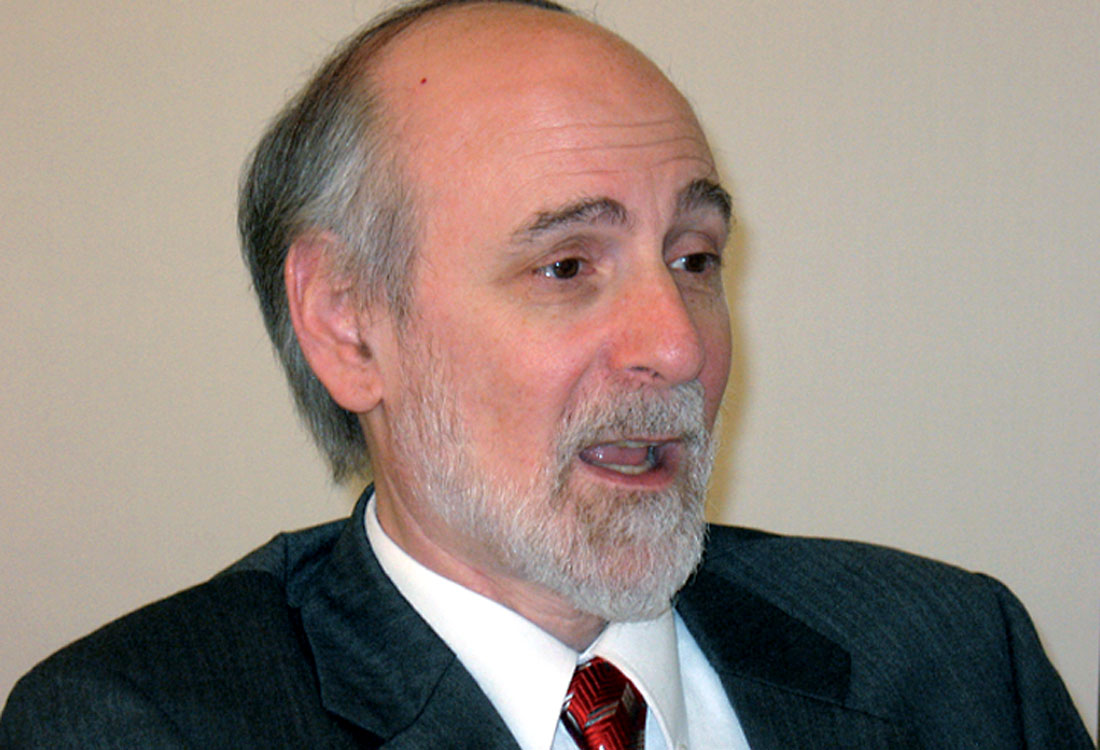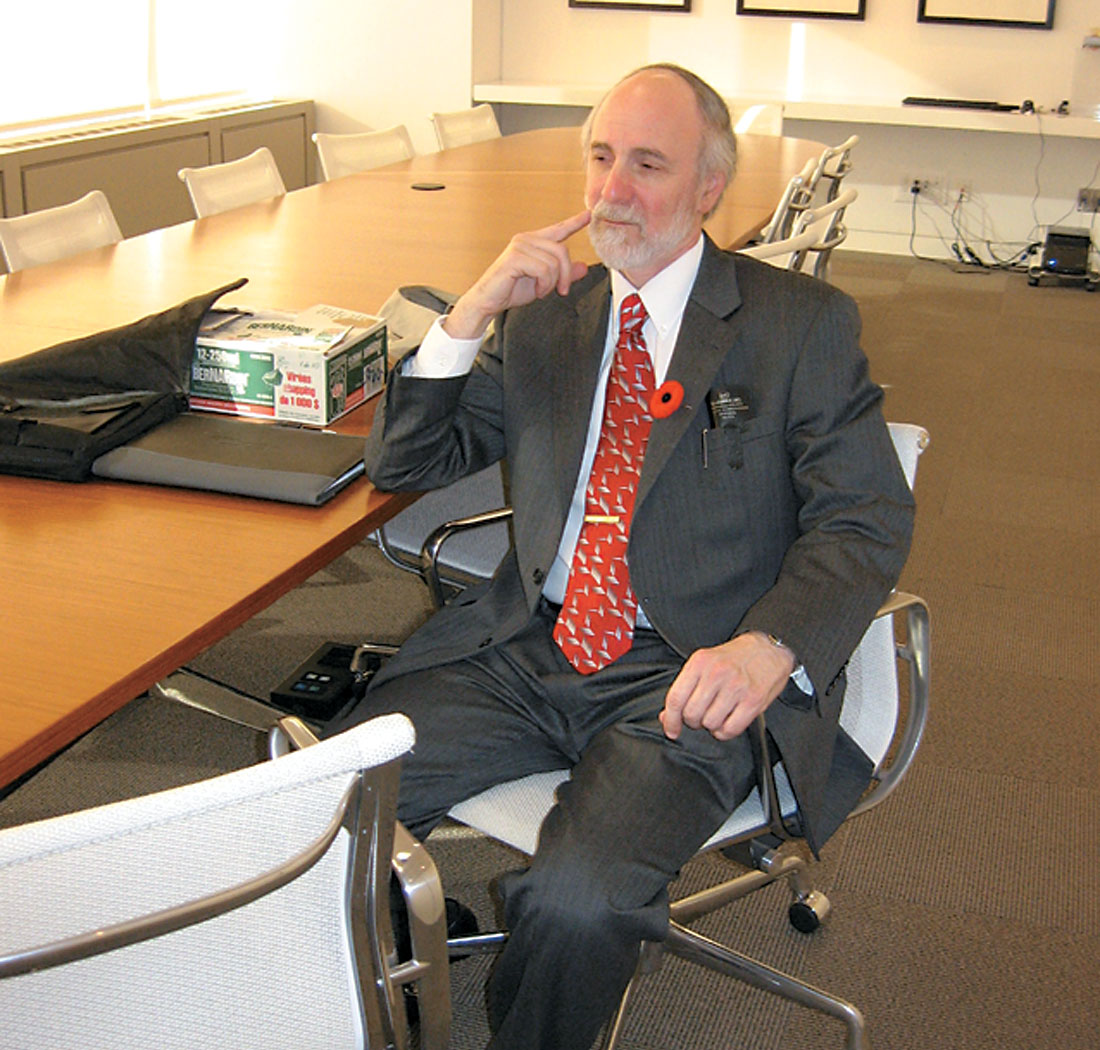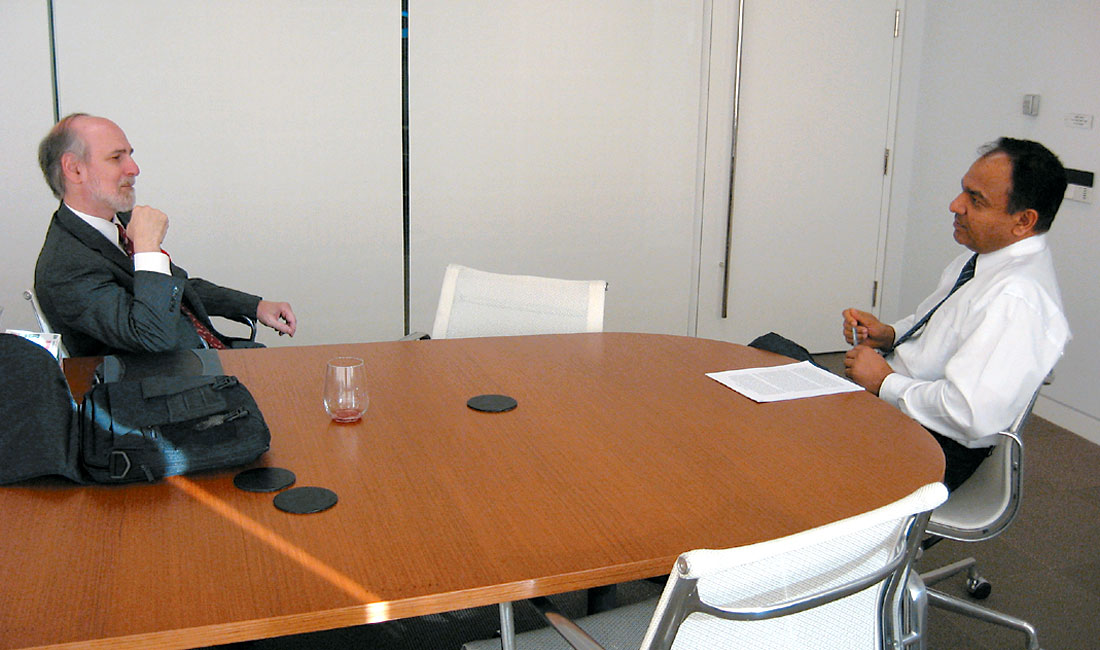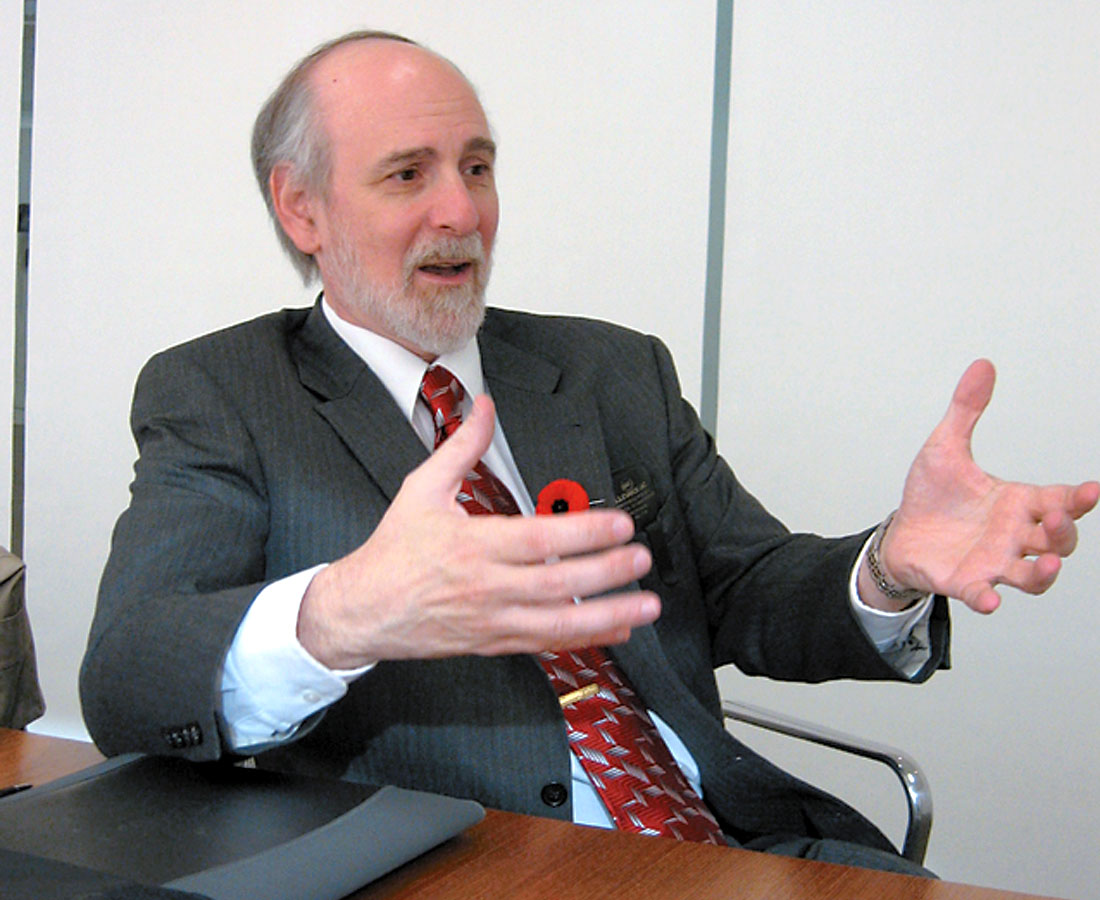
Alan Cohen was invited to give the keynote address at the 2005 Doodle Train, but was unable to attend due to hurricane Katrina. However, he could come back as speaker at the CSEG luncheon on November 5th, 2007, albeit two years later.
Alan has worked for Royal Dutch Shell, for more than 30 years, both in North America and Europe, in various leadership and technical positions. His areas of technical expertise include rock physics, pore pressure prediction, quantitative seismic interpretation, reservoir geophysics and other branches of the geosciences. He now works as a geophysical consultant and Adjunct Professor in the Geology Department of the University of Louisiana at Lafayette, where he teaches a class on the ‘Rock Properties Basis for Seismic Attribute Interpretation’.
This interview was conducted soon after Alan delivered his luncheon talk on ‘Preparing for the Future in Geophysics: Out of Darkness and into the “ Lite”’. Following are excerpts from the interview.
Please tell us about your educational background and your work experience?
First of all, Satinder, thank you for inviting me to participate in this interview. I have been interested in science since my high school days in Montreal. I graduated with a First Class Honours degree in Chemistry from McGill University in 1972 at 21, with a heavy dose of physics and mathematics as well. Then I headed south to Harvard where I received my Masters 2 years later and my Ph.D. 2 years after that concentrating in Solid State Physics and Chemical Physics. After that I was hired by Shell as a geophysicist starting in Houston. I worked at Shell for nearly 29 years, on both sides of the Atlantic, in a variety of technical and leadership capacities, including a stint as Chief Geophysicist for the Western Hemisphere. For about the past two years (after leaving Shell) I have been an Adjunct Professor in the Geology Dept. at the University of Louisiana at Lafayette and also active in the local oil industry there.
After doing your Masters with Physics and Chemistry concentration and getting a Ph.D. in Chemical Physics, what made you switch over to Geophysics? Obviously, you would have good reasons for doing so?
At Harvard I was working on developing quantum mechanical models to predict the elastic properties and phase behavior of crystals (minerals) under high pressures. This topic was of considerable interest to geoscientists trying to understand the seismic velocity structure and composition of the earth’s mantle. I was encouraged to talk with the Harvard Geology Dept. staff. I had never taken a single geology class prior to that. I ended up enrolling in a graduate level class in theoretical seismology taught by Professor Rick O’Connell. I enjoyed that a lot and Rick ended up on my thesis committee. When I was interviewing for jobs after my Ph.D., Shell Oil was very interested in my problem solving skills as a physicist. The company had a good track record of hiring PhD physicists to work at their research lab and in 1976 they were looking for a few more. The fact that I had actually done a thesis on a geophysics-related topic was simply a bonus to them. Shell had a good training program in geology and geophysics and I took good advantage of it to fill in large holes in my geoscience background. As I discussed in my Doodle Train talk today, I firmly believe that our industry needs to attract and quickly train physicists and others to do E&P geophysics, in addition to hiring those already well trained in the discipline.

After doing research for about 6 years you joined Shell and remained with them till you left or retired in 2005. Why did you give up your job at Shell?
I did a short post-doc while waiting for an appropriate visa to continue in the United States. Then I worked for about 7 years at Shell Research, both in Houston and Rijswijk, the Netherlands, working in the Geophysics and the Geology Depts. In 1984 I transferred (permanently it turned out) to the Operating Units of Shell Oil and I worked in a variety of assignments in seismic processing, quantitative interpretation and seismic interpretation (mapping) in Onshore, Shallow Water and especially Deep Water environments. I also created and led a multi-disciplinary reservoir technologies applications team of about 25 geoscientists and engineers and later served as Chief Geophysicist for the Western Hemisphere. I loved my jobs at Shell. I decided to leave shortly after my 54th birthday after nearly 29 years with the company. I had lost my dear wife to cancer about a year or so before that and I had been invited to participate in some cancer- related programs to help others. I was also writing a book unrelated to science. Less than two months after “retiring,” all my plans changed. I fled New Orleans two days prior to Hurricane Katrina making landfall. I ended up losing my house and most of my belongings. I settled a few hours drive away in Lafayette near my daughter and granddaughter and I decided to refocus my energy on projects that might help other geoscientists. I spoke about many of these projects in my DoodleTrain talk today and published some ideas, with your encouragement, in the January 2007 issue of the CSEG RECORDER.
Some people think that to move up the ladder, changing jobs is a must. There are others who opine that staying with one allows you to identify with that company, you grow with the company, there is a sense of belonging that develops in you, and so on. What is your take on this and why?
People are different and have different career goals, job strategies, risk tolerance and so on. At a large oil company like Shell or ExxonMobil you can have a diversity of challenging assignments and great resources. If you perform well, you can often stay at such a company and move to jobs of increasing responsibility and compensation . Others may choose to leave such an environment and move to a smaller company with a greater limelight and the chance to really hit it big, while recognizing the possibility of increased job risk. My overall recommendation is that if you, as a less experienced geophysicist, have any desire for a leadership or management position, you ought to make that desire well known early on in your career. Also, regardless of one’s career goals, find yourself a mentor who can advise you.

What career accomplishments are you most proud of? What were some of the early landmarks in your career that put you on a sound footing?
I am proud of my accomplishments in three different areas: (i) helping people develop as geophysicists; (ii) enhancing the business and HSE impact of geoscience and reservoir technologies; and (iii) novel technical achievements. Shell’s training program served as a firm grounding in the technical arena. My late wife and my children helped me immensely in the people area. Having a variety of assignments outside Shell Research helped to develop my business focus and acumen.
In the technical area, I am most proud of three projects that I worked on. The first two were done with others, whereas the third was largely an individual effort. In the late 1970’s, I helped to develop (with Dave DeMartini et al.) a method to predict compressional and shear wave velocities in sedimentary rocks of mixed mineralogy. My contribution was to employ an approach involving bounding techniques (upper and lower estimates) rather than ad hoc assumptions. This was years before anything like that got published in the open geophysical literature. In the 1990’s I was recognized with two others (Don Haefner and Aaron Seriff) for developing an improved method to predict net feet of pay from seismic and other attributes (called the HSC method at Shell), and for using geological concepts to reconcile that method with existing, less accurate pay prediction techniques. To accomplish that, I relied heavily on a two-year assignment I had early in my Shell career working in the Geology Research department. Finally in 2003, I developed a novel, proprietary method to predict pore pressure from seismic velocity that included important rock properties principles.
What has been your most challenging project?
In 2003, Shell appropriately reinstated Chief’s positions in several different geoscience and engineering disciplines in several geographic regions. I applied for and was awarded the Geophysics job for the Americas Region. I had to coordinate with the other discipline chiefs in my region from geology through facilities engineering and with my geophysical counterparts based in Europe, the Far East and so on. I was responsible for the career development of 175 staff based in 3 different countries in 4 different cities. I had to ensure that the right people with the right skills were assigned to the right projects at the right time to optimize business impact. I was also responsible for technical quality assurance, accelerating technology implementation and the geophysical aspects of reserves auditing. It was indeed a challenging project.
What has been your philosophy towards your professional growth?
I tend to be proactive. My learning style is auditory—I am told that I ask good questions and learn quickly from the answers. I seek out mentors, I avail myself of training opportunities etc. I tend to make things happen. I had no idea back when I left Shell, for example, that I would end up in academia. But I kept my eyes and ears open. And good things happened. These days I seem to be flooded with opportunities in academia.
For characterizing reservoirs, what was the strategy that you followed?
Reservoir characterization and modeling, in my opinion and experience, requires a multi-disciplinary approach. At Shell we combined geochemistry, geology, geophysics, petrophysics and reservoir engineering staff and technologies to better describe and predict the performance of reservoirs. A key enabler was the use of a “shared earth model.” Co-locating the team staff was essential as well. Close collaboration between researchers developing novel technologies, and the teams deploying these technologies to enhance appraisal, field development and production decisions, was critical too. I also led my team to understand, quantify and enhance the business impact of reservoir technologies and to enhance the impact of technology on health, safety and the environment.
In your opinion, what is required for good and effective exploration?
Again, good and effective exploration requires more than just geophysicists making measurements of seismic attributes. It requires a truly multi-disciplinary approach. As we explore in new areas, an understanding of the regional geology is critical. Rock property trends, models and relationships are essential as well. Pre-stack interpretation can be important too. Quantifying and managing risk and uncertainty are truly important to the exploration process.
I notice from your CV that you have spent most of your Shell career working on techniques that characterize reservoirs. Was there any specific reason for this?
Shell, as you are likely aware, was the earliest company exploring and appraising in the Deep Water Gulf of Mexico. Turbidite reservoir characterization and performance prediction was a key element in the overall Deep Water E&P effort. Shell had kicked off efforts in this area within Shell research. My own interest was in accelerating the application of such technology to impact Shell Oil business decisions. As part of an organization called Core Competencies, I was given the opportunity to create, develop, staff and lead a technology applications group based in New Orleans that would work closely with the researchers and with members of our asset teams. Shell ended up awarding many of us, in 1998, for our achievements in this area. This was truly great teamwork. The award certificate survived Katrina. I have a copy on my wall at home in my computer room. It says something like “You folks have changed the way geoscientists perform the basic function of reservoir-scale modeling, enabling dramatic achievements in capability, cycle time and cost.” It was signed by the President & CEO of Shell E & P. I worked heavily in this area from 1995 through the end of 2002.
Reservoir geophysics is a term that we have started hearing over the last 6-8 years. Before that it was more of Development or Production seismology, or something like that…Why do you think this term got coined?
Various technologies impact Development and Production phases of the business lifecycle. Some impact well decisions, some impact reservoir decisions and so on. In that sense, “reservoir” geophysics is a crisper term. Besides that, reservoir geophysics can impact Appraisal, Redevelopment and other lifecycle phases as well.

Do you think new geophysical technologies hold the promise of extraction of more information for characterizing hydrocarbon reservoirs? How effectively did you use them in your interpretation for lowering of risk, so to say?
I am a firm believer in new technologies. For example, I helped Shell accelerate the application of proprietary seismic inversion technologies, in the 1990s, which definitely improved reservoir characterization by ensuring that our reservoir models were seismically consistent and objective. These days I believe there is much that we can learn from more and better applications of immersive, visualization technologies to map geological bodies, compartments and so on, and to understand their flow behavior. I alluded to this during my Doodle Train talk. The LITE (Louisiana Immersive Technologies Enterprise) Center in Lafayette, Louisiana, for example, has some capabilities that are worthwhile considering by our industry. It has some incredible visualization venues and some really smart computer scientists.
As you have mentioned, you are a firm believer in technology. Over the years what new technology ideas did you assimilate in your interpretation (which others did not at the time) and was the outcome favourable? Why do you believe so?
Seismic inversion was used to create seismically consistent, objective models (note I did not say one model here) to better interpret data and make better business decisions. Appropriate rock property modeling has always played and continues to play a key role as well. That modeling involves both physics and geology. To me, that is more than simply rock physics. I also championed the application of neural nets and other statistical methods at Shell and co-authored some papers on this in the open literature with Dr. Sandhya Devi. Sometimes geophysicists look askance at statistical methods because they seem like “black boxes” whose inner workings are not well understood. I believe that they have a place in our toolkit when applied appropriately. For example, we were able to improve our Deep Water Gulf of Mexico probability of success by combining AVO and neural net technologies.
I notice on your website, you conduct a course entitled ‘Rock Properties Basis for Seismic Attribute Interpretation’. Could you tell us about it?
I would be glad to. I spent quite a few months preparing for this class which will run from January through May of 2008 at University of Louisiana at Lafayette. Shell graciously provided me with some materials and I found others in the open literature. The class is for graduate students in the geosciences and engineering. Suitably-qualified seniors may want to take it as well. My goal is to enhance each student’s physical and geological intuition. There are plenty of exercises (I invented most of these) that are tied to seismic attribute or “sonic” log interpretation. There is a team project and openbook quizzes and exams. I am excited about teaching this class. Several oil industry geophysicists are also planning to attend. Some topics include: seismic attribute calibration, rock property measurement methods, rock property relations and models, the rock properties basis of pore pressure prediction, of shear wave interpretation, and of AVO interpretation, just to give you a flavor of the course.
Once they have gained enough experience, or after retirement some geoscientists like to work as consultants, like yourself. What are your views on consulting? Do you think it was a good decision?
People will do what they like to do. I’d like to see a more flexible, less abrupt model for the “retirement” phase of our industry. I dislike the model where near age 55 most geophysicists exit our profession. That will hardly help us prepare well for the “great crew change.” Employing geophysicists as consultants, or on some part-time basis with benefits, would be better in my opinion. I’ll refer people to my Doodle Train talk for further details.

You are a registered member of SEG and SWLGS (South West Louisiana Geophysical Society). Tell us from your experience, how does becoming a member of such professional societies help?
I have been an active SEG member since 1979. I think the SEG annual convention and its topical summer workshops are well worth attending. More importantly we need to all help improve the health and future of the E&P geophysical community. Professional societies such as SEG and SWLGS provide a venue to accomplish this.
You are also active in a geo-mentoring committee. Tell us about your teaching philosophy and how you go about mentoring our younger friends.
First, let me direct folks who are interested in the new SEG Geo-Mentoring Committee to contact Bill Barkhouse, who is heading that committee. My teaching philosophy is to help improve my students’ geological and physical intuition. Mentoring is also a key part of that. The class team project will likely bring geoscience and engineering students into closer collaboration with one another and with members of the Lafayette oil and gas industry, as they solve problems together. I also gave a talk at the university to geoscience graduate students to pre p a re them for job interviews.
What are your other interests?
My family and church are very important to me. I am also dating a wonderful woman, Tammy. I am interested in financial projects, especially investing in stocks, bonds and collectibles. I collect circa 1930 vacuum tube radios, especially with shortwave bands, and I enjoy playing them. I enjoy movies, reading and travel.
What would be your message for young entrants in our industry?
Geophysics is a wonderful profession. Each day as an E&P geophysicist can be different and exciting. I would urge young entrants to seek out a mentor and to attend appropriate training classes. I would push for technical excellence but with strong business focus. Teamwork is also critical. If you have a desire for a leadership or management position, make that known at the earliest opportunity. Above all, learn, apply what you learn and have fun. You are our future!











Share This Interview